Ganz Works
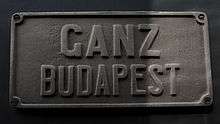 | |
| Private company (former state company) | |
| Industry |
transport vehicle manufacturing iron and steel manufacturing |
| Founded | 1845, Budapest, Habsburg Empire |
| Founders | Ábrahám Ganz |
| Headquarters |
Budapest, Habsburg Empire (1845-1867) Budapest, Austria-Hungary (1867-1918) Budapest, Hungary (1918-1949) |
Area served | Worldwide |
Key people |
Ábrahám Ganz Károly Zipernowsky Ottó Bláthy Miksa Déri András Mechwart Kálmán Kandó Donát Bánki János Csonka |
| Products |
tramcars trains ships electrical generators |
| Owner |
Ábrahám Ganz and his family (1845-1947) State of Hungary (1946-1949) |
| Subsidiaries |
Ganz Danubius (ships) Ganz Acélszerkezet (bridge steel structures) Ganz Transelektro (high-voltage equipment) |
| Website | http://ganzdata.hu/ |

The Ganz Works or Ganz (Hungarian: Ganz vállalatok or Ganz Művek, Ganz enterprises or Ganz companies) was a group of companies operating between 1845 and 1949 in Budapest, Hungary. It was named after Ábrahám Ganz, the founder and the manager of the company. It is probably best known for the manufacture of tramcars, but was also a pioneer in the application of three-phase alternating current to electric railways. Ganz also made ships (Ganz Danubius), bridge steel structures (Ganz Acélszerkezet) and high-voltage equipment (Ganz Transelektro). Since 1989, various parts of Ganz have been taken over by other companies.
History
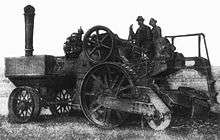
Before 1919, the company built ocean liners, dreadnought type battleships and submarines, power plants, automobiles[1][2] and many types of fighter aircraft.[3]
The company was founded by Abraham Ganz in 1844. He established his own iron foundry in Buda in the Kingdom of Hungary. Consequently, this factory played an important role in building the infrastructure of the Hungarian Kingdom and the Austro-Hungarian Empire. At this time the agricultural machines, steam-locomotives, pumps and the railway carriages were the main products. At the beginning of the 20th century, 60 to 80% of the factory's products were sold for export.
At the end of the 19th century, the products of the Ganz and Partner Iron Mill and Machine Factory (hereinafter referred to as Ganz Works) promoted the expansion of alternating-current power transmissions.
Prominent engineers
Prominent engineers at Ganz works included András Mechwart, Károly Zipernowsky, Miksa Déri, Ottó Titusz Bláthy, Kálmán Kandó and Ernő Wilczek.
Power plants, generators turbines and transformers
In 1878, the company's general manager András Mechwart founded the Department of Electrical Engineering headed by Károly Zipernowsky. Engineers Miksa Déri and Ottó Bláthy also worked at the department producing direct-current machines and arc lamps.
- Generators
The first turbo generators were water turbines which drove electric generators. The first Hungarian water turbine was designed by engineers of the Ganz Works in 1866. Mass production of dynamo generators started in 1883.[4]
The missing link of a full Voltage Sensitive/Voltage Intensive (VSVI) system was the reliable alternating current constant voltage generator. Therefore the invention of the constant voltage generator by the Ganz Works in 1883[5] had a crucial role in the beginnings of industrial scale AC power generation, because only these type of generators can produce a stable output voltage, regardless of the actual load.[6]
- Transformers
In cooperation, Zipernovsky, Bláthy and Déri (known as the ZBD team) constructed and patented the transformer. The "transformer" was named by Ottó Titusz Bláthy. The three invented the first high efficiency, closed core shunt connection transformer. They also invented the modern power distribution system: Instead of a series of connections they connected supply transformers in parallel to the main line.[7]
The transformer patents described two basic principles. Loads were to be connected in parallel, not in series as had been the general practice until 1885. Additionally, the inventors described the closed armature as an essential part of the transformer. Both factors assisted the stabilisation of voltage under varying load, and allowed definition of standard voltages for distribution and loads. The parallel connection and efficient closed core made construction of electrical distribution systems technically and economically feasible.
The Ganz Works built the first transformers using iron plating of enamelled mild iron wire, and started to use laminated core at the end of 1885.
- Power stations
In 1886, the ZBD engineers designed, and the company supplied, electrical equipment for the world's first power station to use AC generators to power a parallel connected common electrical network. This was the Italian steam-powered Rome-Cerchi power plant.[8]
Following the introduction of the transformer, the Ganz Works changed over to production of alternating-current equipment. For instance, Rome's electricity was supplied by hydroelectric plant and long-distance energy transfer.[9]
- Electricity meters
The first mass-produced kilowatt-hour meter (electricity meter), based on Hungarian Ottó Bláthy's patent and named after him, was presented by the Ganz Works at the Frankfurt Fair in the autumn of 1889, and the company was marketing the first induction kilowatt-hour meter by the end of the year. These were the first alternating-current wattmeters, known by the name of Bláthy-meters.[10]
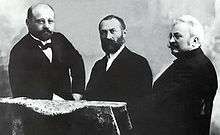
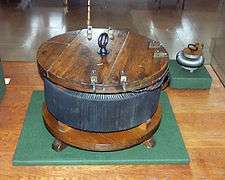 Prototypes of the world's first high efficiency transformers (Széchenyi István Memorial Exhibition, Nagycenk, Hungary, 1885)
Prototypes of the world's first high efficiency transformers (Széchenyi István Memorial Exhibition, Nagycenk, Hungary, 1885)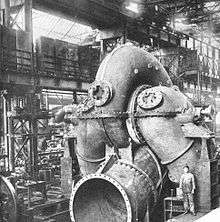 The construction of a Ganz water turbo generator in 1886
The construction of a Ganz water turbo generator in 1886 PSM V56 D0433 Direct connected electric railway generator in 1899
PSM V56 D0433 Direct connected electric railway generator in 1899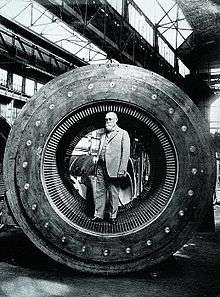 Ottó Bláthy in the armature of a Ganz turbo generator (1904)
Ottó Bláthy in the armature of a Ganz turbo generator (1904) Ganz 21.000 kW Transformer, Hungary in 1911, weight: 38t
Ganz 21.000 kW Transformer, Hungary in 1911, weight: 38t A generator assembly hall of the Ganz Works in 1922
A generator assembly hall of the Ganz Works in 1922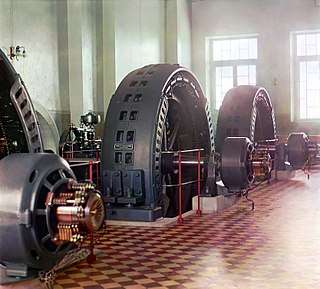 Alternators in a hydroelectric station on the Murghab River.
Alternators in a hydroelectric station on the Murghab River.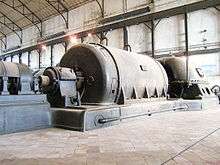 Generator in Zwevegem, West Flanders, Belgium
Generator in Zwevegem, West Flanders, Belgium
Internal combustion engines and vehicles


The beginning of gas engine manufacturing in Hungary is linked to Donát Bánki and János Csonka but it is not clear that they ever worked for Ganz.
Ganz produced engines whose designs were licensed to Western European partners, notably in the United Kingdom and Italy.
- Timeline
- 1889 the first four-stroke gas engine was built by the Ganz factory
- 1893 the manufacture of paraffin and petrol fuelled engine with carburetor
- 1898 the manufacture of engines with the Bánki water injection system
- 1908 the introduction of a new petrol engine type, the series Am
- 1913 the manufacture of Büssing petrol engines for trucks
- 1914–18 the manufacture of fighter plane engines
- 1916 the manufacture of petrol engines, type Fiat
- 1920 the modification of petrol engines for suction gas operation
- 1924 György Jendrassik started his engine development activity
- 1928 the first railway diesel engine was completed, according to the plans of Ganz-Jendrassik
- 1929 the first export delivery of a railway engine using the system of Ganz-Jendrassik
- 1934 there was an engine reliability World Competition in the USSR where the Ganz engine achieved the best fuel consumption in its category
- 1939-42 construction of the Jendrassik Cs-1 turboprop engine
- 1944 the first application of the engine type XII JV 170/240 in a motor-train set
- 1953 modernisationon of the diesel engine system Ganz-Jendrassik
- 1959 the union of the Ganz factory and the MÁVAG company, establishing Ganz-MÁVAG
Railways

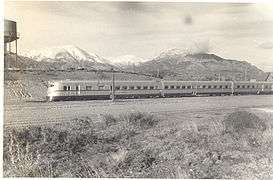

The Ganz Company started to construct steam locomotives and steam railcars from the 1860s.
Between 1901 and 1908, Ganz Works of Budapest and de Dion-Bouton of Paris collaborated to build a number of railcars for the Hungarian State Railways together with units with de Dion-Bouton boilers, Ganz steam motors and equipments, and Raba carriages built by the Raba Hungarian Wagon and Machine Factory in Győr. In 1908, the Borzsavölgyi Gazdasági Vasút (BGV), a narrow-gauge railway in Carpathian Ruthenia (today's Ukraine), purchased five railcars from Ganz and four railcars from the Hungarian Royal State Railway Machine Factory with de Dion-Bouton boilers. The Ganz company started to export steam motor railcars to the United Kingdom, Italy, Canada, Japan, Russia and Bulgaria.[11][12][13]
The Ganz Works, having identified the significance of induction motors and synchronous motors, commissioned Kálmán Kandó to develop them. In 1894, Hungarian engineer Kálmán Kandó developed high-voltage three-phase AC motors and generators for electric locomotives. The first-ever electric rail vehicle manufactured by Ganz Works was a 6 HP pit locomotive with direct current traction system. The first Ganz made asynchronous rail vehicles (altogether 2 pieces) were supplied in 1898 to Évian-les-Bains (France) with a 37 HP asynchronous traction system. The Ganz Works won the tender for electrification of the Valtellina Railway in Italy in 1897. Under the management, and on the basis of plans from Kálmán Kandó, three phase electric power at 3 kV and 15 Hz was fed through two upper wires and the rails. The electricity was produced in a dedicated power station and the system operated for thirty years from 1902. Italian railways were the first in the world to introduce electric traction for the entire length of a main line rather than just a short stretch. The 106 km Valtellina line was opened on 4 September 1902, designed by Kandó and a team from the Ganz works.[14][15] The voltage was significantly higher than used earlier and it required new designs for electric motors and switching devices.[16][17] The three-phase two-wire system was used on several railways in Northern Italy and became known as "the Italian system". Kandó was invited in 1905 to undertake the management of Società Italiana Westinghouse and led the development of several Italian electric locomotives.[16] In 1918,[18] Kandó invented and developed the rotary phase converter, enabling electric locomotives to use three-phase motors whilst supplied via a single overhead wire, carrying the simple industrial frequency (50 Hz) single phase AC of the high-voltage national networks.[15]
After World War I, at the Ganz Works, Kálmán Kandó constructed a single-phase electric railway system using 16 kV at 50 Hz. A similar system, but using 15 kV at 16.7 Hz, later became widely used in Europe. The main attribute of Kandó's 50 Hz system was that it was fed by the normal power network, so dedicated railway power stations became unnecessary. Because of the early death of Kálmán Kandó, László Verebélÿ continued the work for the Hungarian State Railways (MÁV).[19]
Rail rolling stock
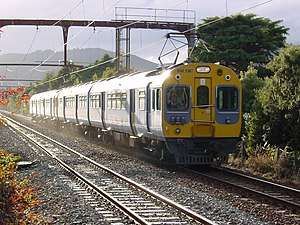

In 1959 Ganz merged with the MÁVAG company and was renamed Ganz-MÁVAG.
In 1976 Ganz-Mávag supplied ten standard gauge 3-car diesel trainset to the Hellenic Railways Organisation (OSE), designated as Class AA-91 and four metre gauge 4-car trainsets, designated as Class A-6451. In 1981/82 Ganz-Mávag supplied to OSE 11 B-B diesel-hydraulic DHM7-9 locomotives, designated as class A-251. Finally, in 1983, OSE bought eleven 3-car metre gauge trainsets, designated as Class A-6461. All these locomotives and trainsets have been withdrawn with the exception of one standard and one metre gauge trainset.
In 1982/83 Ganz-Mávag supplied an order for electric multiple units to New Zealand Railways Corporation for Wellington suburban services. The order was made in 1979, and was for 44 powered units and 44 trailer units, see New Zealand EM class electric multiple unit.
Trams
Ganz-MÁVAG delivered 29 trams (2 car sets) to Alexandria, Egypt from 1985 to 1986.[20]
Shipbuilding
In 1911, The Ganz Company merged with the Danubius shipbuilding company, which was the largest shipbuilding company in Hungary. From 1911, the unified company adopted the "Ganz–Danubius" brand name. As Ganz Danubius, the company became involved in shipbuilding before, and during, World War I. Ganz was responsible for building the dreadnought SMS Szent István, all of the Novara-class cruisers, and built diesel-electric U-boats at its shipyard in Budapest, for final assembly at Fiume. Several U-boats of the U-XXIX class, U-XXX class, U-XXXI class and U-XXXII class were completed,[21] A number of other types were laid down, but remained incomplete at the war's end.[22] By the end of the First World War, 116 naval vessels had been built by The Ganz-Danubius company. The company built some ocean liners too.
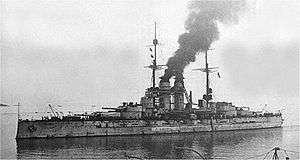
 SM U-29 submarine of the Austro-Hungarian Navy, built by the Ganz-Danubius company
SM U-29 submarine of the Austro-Hungarian Navy, built by the Ganz-Danubius company The back of SM U-31 submarine during its assembly in the Ganz–Danubius Company on 24 April 1916
The back of SM U-31 submarine during its assembly in the Ganz–Danubius Company on 24 April 1916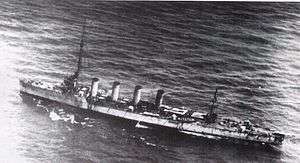 The battle-damaged SMS Novara (1913) after a victorious naval battle
The battle-damaged SMS Novara (1913) after a victorious naval battle
Aircraft
The first Hungarian "aeroplane factory" was founded by the Ganz Company and Weiss-Manfréd Works in 1912. During World War I, the company made many types of Albatros and Fokker fighter planes.
The world's first turboprop engine was the Jendrassik Cs-1 designed by the Hungarian mechanical engineer György Jendrassik. It was built and tested in the Ganz factory in Budapest between 1939 and 1942. It was planned to be fitted to the Varga RMI-1 X/H twin-engined reconnaissance bomber designed by László Varga in 1940, but the program was cancelled. Jendrassik had also designed a small-scale 75 kW turboprop in 1937.
After World War II
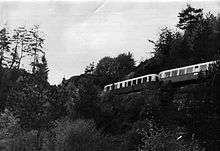

In 1947, the Ganz Works was nationalised and in 1949 it became independent and six big companies came into existence, including the Ganz Transformer Factory. In 1959, Ganz Wagon and Machine Factory merged with the MÁVAG Locomotive and Machine Factory under the name of Ganz-MÁVAG Locomotive, Wagon and Machine Works. Of the products of the Works, outstanding results were shown in the field of the manufacture of diesel railcars and multiple units. Traditional products included tramcars as well, and customers included the tramway network of Budapest. In the meantime the Foundry workshop was closed down.
In 1974, the locomotive and wagon Works were merged under the name of Railway Vehicle Factory and then the machine construction branch went through significant development. The production of industrial and apartment house lifts became a new branch. Ganz-MÁVAG took over a lot of smaller plants in the 1960s and 1970s and their product range was extended. Among other things, they increased their bridge-building capacity. They made iron structures for several Tisza bridges, for the Erzsébet Bridge in Budapest, for public road bridges in Yugoslavia and for several industrial halls.
The Ganz Shipyard experienced its most productive times during the four decades following nationalisation. In the course of this period 1100 ship units were produced, the number of completed seagoing ships was 240 and that of floating cranes was 663. As a result of the great economic and social crises of the 1980s, Ganz-MÁVAG had to be reorganised. The company was transformed into seven independent Works and three joint ventures.
Ganz since 1989
In 1989, the British company Telfos Holdings gained a majority of the shares in Ganz Railway Vehicle Factory Co. Ltd. and the name of the company was changed to Ganz-Hunslet Co. Ltd. In the course of 1991 and 1992, the Austrian company Jenbacher Werke obtained 100% of the company's shares and consequently the railway vehicle factory is now a member of the international railway vehicle manufacturing group, Jenbacher Transport Systeme. At present, the Ganz Electric Works, under the name of Ganz-Ansaldo is a member of the Italian industrial giant, AnsaldoBreda. The Ganz Works were transformed into holdings. Ganz-Danubius was wound up in 1994. The Ganz Electric Meter Factory in Gödöllő became the member of the international Schlumberger group.
In 2006, the power transmission and distribution sectors of Ganz Transelektro were acquired by Crompton Greaves,[23] but still doing business under the Ganz brand name, while the unit dealing with electric traction (propulsion and control systems for electric vehicles) was acquired by Škoda Transportation and is now a part of Škoda Electric.[24]
References
- ↑ Iván Boldizsár: NHQ; the New Hungarian Quarterly, Volume 16, Issue 2; Volume 16, Issues 59–60, p. 128
- ↑ Hungarian Technical Abstracts: Magyar Műszaki Lapszemle, Volumes 10–13, p. 41
- ↑ Iván T. Berend: Case Studies on Modern European Economy: Entrepreneurship, Inventions, and Institutions, p. 151
- ↑ http://www.sze.hu/~mgergo/EnergiatudatosEpulettervezes/2013_1_feladat/ErosErika/V%EDzenergia%20hasznos%EDt%E1s%20szigetk%F6zi%20szemmel%20EL%D5AD%C1SANYAG.pdf%5Bpermanent+dead+link%5D
- ↑ American Society for Engineering Education (1995). Proceedings, Part 2. p. 1848.
- ↑ Robert L. Libbey (1991). A Handbook of Circuit Math for Technical Engineers. CRC Press. p. 22. ISBN 9780849374005.
- ↑ "Bláthy, Ottó Titusz". Retrieved 20 December 2016.
- ↑ "Ottó Bláthy, Miksa Déri, Károly Zipernowsky". IEC Techline. Archived from the original on September 30, 2007. Retrieved Apr 16, 2010.
- ↑ Hungarian Inventors and their Inventions Archived 2012-03-22 at the Wayback Machine.
- ↑ Eugenii Katz. "Blathy". Clarkson University. Archived from the original on June 25, 2008. Retrieved 2009-08-04.
- ↑ Railroad Gazette - Volume 37 - Page 296 (printed in 1904)
- ↑ Modern Machinery - Volumes 19-20 - Page 206 (Printed in 1906)
- ↑ John Robertson Dunlap, Arthur Van Vlissingen, John Michael Carmody: Factory and Industrial Management - Volume 33 - Page 1003 (printed in 1907
- ↑ Duffy (2003), p. 120-121.
- 1 2 Hungarian Patent Office. "Kálmán Kandó (1869–1931)". www.mszh.hu. Retrieved 2008-08-10.
- 1 2 "Kalman Kando". Retrieved 2011-10-26.
- ↑ "Kalman Kando". Archived from the original on 2012-07-12. Retrieved 2009-12-05.
- ↑ Michael C. Duffy (2003). Electric Railways 1880-1990. IET. p. 137. ISBN 9780852968055.
- ↑ "Ganz and Tungsram - the 20th century". Electric History. EnergoSolar.com. 2007. Archived from the original on 6 January 2009. Retrieved 20 December 2016.
- ↑ "Archived copy" (PDF). Archived from the original (PDF) on 2015-01-10. Retrieved 2015-01-10.
- ↑ R.H. Gibson, Maurice Prendergast (2002). The German Submarine War 1914–1918. Periscope Publishing Ltd. p. 386. ISBN 9781904381082.
- ↑ http://www.gwpda.org/naval/ahsubs.htm Sieche article on KuK U-Boats
- ↑ Ganz is now CG Retrieved 2009-11-28.
- ↑ info@lundegaard.cz, Lundegaard - e-business solutions provider, www.lundegaard.cz,. "Česká verze - ŠKODA TRANSPORTATION a.s." Archived from the original on 13 April 2008. Retrieved 20 December 2016.
External links
| Wikimedia Commons has media related to Ganz Works. |